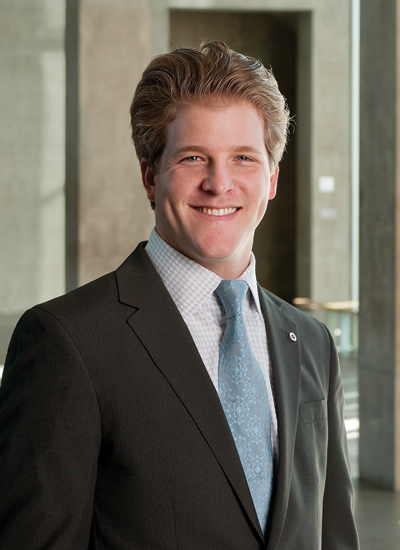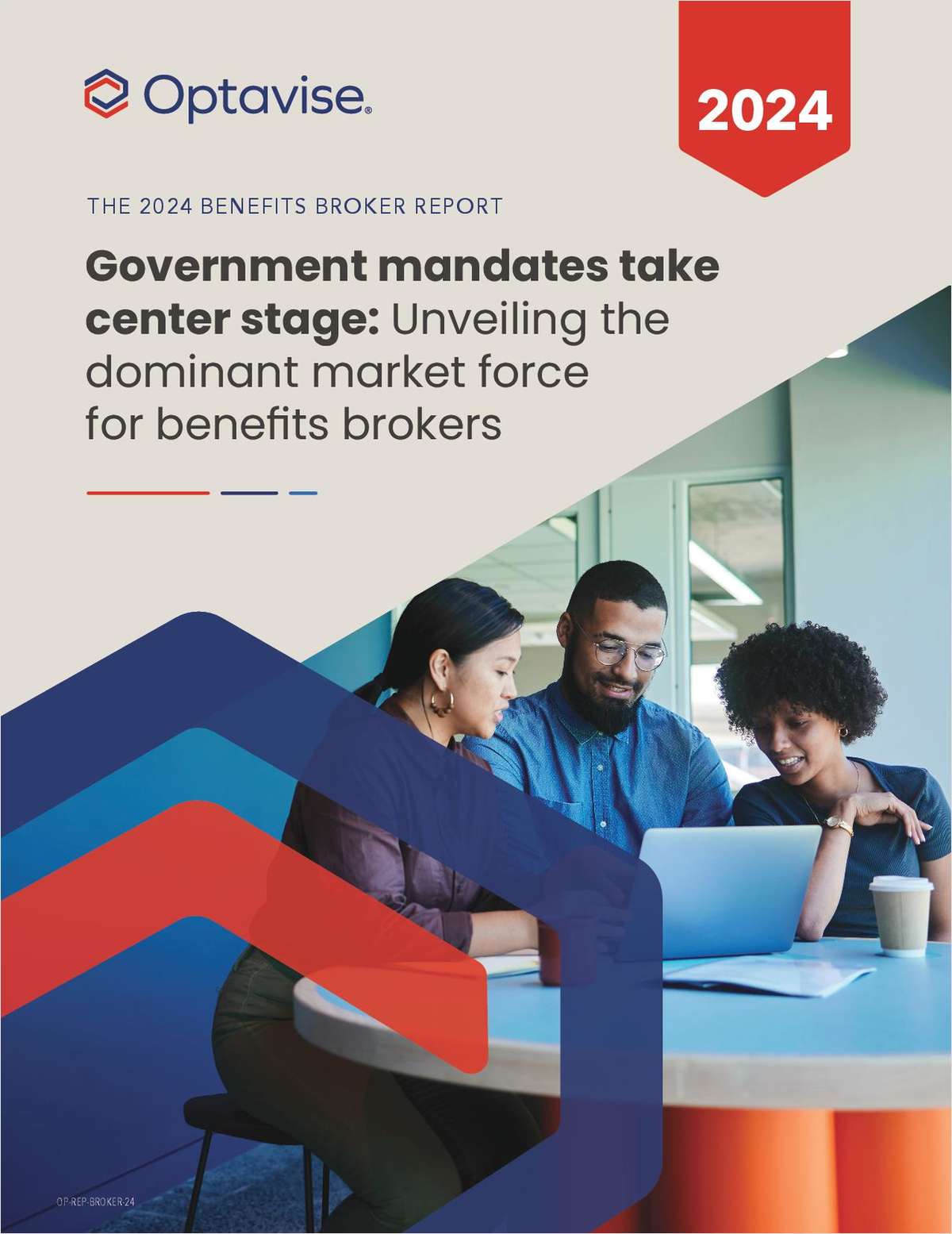
Photo by Jim Olvera
Family gatherings with Matt Stadler’s family are interesting tohim, though they admittedly bore his wife, Katie. At holidays, thesenior vice president of Dallas-based Frost Insurance talks aboutregulations, insurance trends and which direction the market isgoing with the other Stadlers—his dad Mark, and his brother, Adam,who happen to work at the same self-funding group (which Matt does business with, too).
|“We’ll have a lot of disagreements on what’s a ‘next practice’or a ‘best practice.’ Insurance companies provide a lot of greatproducts, but the delivery in our business—as a consultant, as abroker, as an adviser, whatever you consider yourself—is our placeto shine. We talk about how do we deliver something better thanwhat it is right now.”
|“Whether we agree or disagree, it’s fun,” he says. “They’vesharpened the tool set I have, offering challenges and conversationI may not get elsewhere.”
|Despite insurance being in his blood, anyone who knows theyoungest Stadler probably will agree he’s successfully paved hisown path. At just 29, Stadler is what colleague Brian Latkowskicalls one of the most gifted benefits advisers in the country.
|That’s because of his “ongoing commitment to gathering industryknowledge and providing innovative solutions,” a glaring example,Latkowski says, “of what most our customers are looking for in apartner, a true business adviser.”
|For his part, Stadler is quick to give credit to Frost, anorganization, he says, based on high ethical standards, a rarity inmost businesses today.
|“It’s something a lot of people have on a piece of paper,” hesays. “They have a mission statement because everyone else does. Ithink ours is more reflective of who we are and not theopposite.”
|It’s the kind of company people are actually excited about,Stadler promises, himself included.
|And this is what works for him—treating each client as his mostimportant, making them trust him, giving employers advice based onwhat they need, not on what they want to hear or on what he wantsto sell. It’s what keeps his clients coming back to him. It’s whathas helped him exceed sales goals by 25 percent in 2008, 120percent in 2009, 270 percent in 2010 and 250 percent in 2011.Though for him, it’s not just about the numbers.
|Instead, Stadler is all about the relationships. It’s a concepthe learned growing up in Chicago, communicating with his father andhis father’s friends who were salesmen, too. He got a good grasp ofrelationships in textbook format, when he studied communicationsciences and disorders at Texas Christian University. And hepracticed it firsthand before committing himself into the healthcare industry (beginning as a sales executive at Great-WestHealthcare) when he worked as a financial adviser for two years atSmith and Associates in Fort Worth, Texas.
|“That financial background allowed me to get a grasp ofcompanies’ financials quicker,” Stadler says. “It was the product Iunderstood quickly, and I became an asset to brokers at that time,calling on them to understand employers meet their bottom linereads.”
|That, he says, helped him find a niche—a salesperson whounderstood both the value of the product and the value of theemployer’s bottom line.
|Ask him if he’s worried about health care reform or unemploymentnumbers or the state of the economy, and he’ll tell you no. Itexcites him, and it makes him an expert on subjects that franklyscare other people. These “challenges,” he claims, gives him anopportunity to work with people on an entirely different level.
|Plus, it gives him another opportunity to think ahead. Stadler’sstrategy is thinking long-term: Nothing, he tells employers, can bedone without a roadmap. Planning is how employers will get to thepoint of offering “something unique other employers aren’toffering.”
|“[Employers] need to be preparing for their future financially,”Stadler says. “If you aren’t planning long-term in today’s culturewith working with benefits and working with employees, you’vealready missed the ship.”
||Benefits Selling: How’s business going? Withthe economy the way it is, and health reform ramping up, how arepeople reacting?
|Matt Stadler: It’s an interesting time. Clientsand employers see a major fork in the road with health care reform.The big question is where are we going from here and what are wedoing, because health care reform will always be a part of ourlandscape and our future. So what I tell clients and prospects isthey want to set rules. They understand they’re paying a lot ofmoney for benefits these days, they’re shelling out cash for it andthey want to be sure their employees are really receiving a benefitthat they’re helping frame and control how they’re being used on aday-to-day basis.
|You’ve got multiple generations working for these companies andthey all interpret data differently and purchase benefitsdifferently. And with health reform looming, it’s important.
|For these companies they’re competing for the best employees andproviding outstanding benefits. Others say they don’t think they’reable to do that much longer, so we help them develop an exitstrategy and help their employees transition, or come up with acompensation strategy.
|BS: Dropping benefits scares alot of people. How much of that are you seeing?
|MS: I wouldn’t say a tremendous amount, but inthe back of employers’ minds, [they’re thinking] what’s the best option for my company, my financial situation and how do weput ourselves in the best light in 2014 and going forward? Whetherthey’re going to keep benefits or drop them, everybody’s havingthat conversation at least on some level. And they need to be.
|[Read "Survey:Employers will drop coverage if competition does"]
|BS: With this double whammy of hits for yourbusiness—and for employers—does either hurt you more?
|MS: There are a lot of opinions on healthreform and the economy. A lot of people say the economy is justkilling us, people are laying off employees and it’s hurting usfinancially. And I hear people say health reform will kill thisbusiness, and that’s a sad thing to hear. What I see is actuallythe opposite, that it creates opportunity for you to be an adviserto your client and your marketplace. It gives an opportunity forpeople to look at you like an expert. Rather than focusing oncommission dollars, focus on your clients.
|For example I have a client who’s hurting financially. They’vegot problems with revenue coming in, they can’t keep employees onstaff because they can’t afford to pay them and they were gettinghit hard by a big renewal this year. At Frost, we havepriorities—that we are a safe and sound place to do business, andeverybody is significant. I told them offering a full-blownbenefits plan might not be something you can do, because if anemployee is looking at their benefits or their job, they need theirjob. And as a broker, that’s money directly off what we’re making.But we’re doing the right thing for the client and it makes me intoadviser capacity, and for them, that client will come back.
||BS: You’ve touched on relationships, and you’veearned your degree in communications studies—just how important arerelationships?
|MS: Trust is a big factor in this business.This is not a product-based business; it’s a relationship-basedbusiness. It’s one where if you can get engrained into the cultureof your clients, you can understand their needs better, you can fitsolutions that fit better within their systems.
|BS: Tell me a little about Frost and what makesit different.
|MS: Frost is unique in its culture. We’ve gotsomething called a blue book engrained in our system as a new hire.Our CEO...comes to each location and that’s what he talks about.The blue book outlines what kind of character we have... We treateveryone as significant and that goes from the top down. There area lot of great brokers and consultants out there as individuals whoare doing fantastic things, but what sets us a part is ustogether.
|BS: You have some great sales numbers. How doyou do it?
|MS: It’s not showing up to a client once a yearor twice a year and saying ‘Here’s what your renewal looks like.’It’s developing a relationship with them and their needs. How’syour payroll? Do you have a wellness program? Would you like one? If you go out and talkabout best practices today, you’re behind the curve. You need to betalking about next practices. I think my success is directly tiedto looking at things a little bit differently, bringing solutionsto the table, being proactive and not reactive. Also it’s anemphasis on who I work for—Frost has fantastic marketrecognition.
|BS: You talk about nextpractices versus best practices. What’s thedifference?
|MS: Best practices are finding financiallystrong insurance companies and products to disperse to yourclients. It’s doing enrollment meetings and your best to educatethem in that context. It’s talking about wellness programs as howthey used to be or how they are.
|Next practices are diving in, finding out how to streamline HRservices, how to develop more significant communication channelsand streams to your employees, how to develop an insurance orhealth care program around what your employees are actually usingrather than just picking benefits out of a box and handing themout. It’s developing on-site health clinics, telemedicineclinics—something I think will be great for satellite locations,and that’s where you are speaking virtually to your doctor via atelevision set, essentially. I think those are things that will becost effective, ways to create benefits to your employees. It’sabout looking at new ways to deliver care, analyze data and deliverbenefits and new ways to take that communication campaign to everyemployee and how they use benefits specifically.
|BS: What do your clients connectto?
|MS: A different response. Everybody has thesame question about how they want better benefits at a betterprice. It’s a great goal and attainable in some situations, but Ithink they’re looking for a partner in some sense who will not givethem a cookie cutter response about how things are. I think theywant someone who’s gonna say ‘Let’s talk about who you are as acompany; let’s talk about where the market is going, what healthcare reform is doing and what the Supreme Court will decide and howthat will affect your company’s situation. And let’s prepare forhow that will affect you today so that tomorrow we aren’t lookingback saying ‘what’s going on, what happened?’’
|BS: Trends to watch this year in health care?
|MS: Supreme Court ruling on the individualmandate. One of the first questions I get when I meet with clientsis ‘What’s happening with health reform?’ They always want anupdate. I tell them to plan for health reform being a part of ourlandscape, because it will be. Plan ahead, then you don’t have toworry. Make sound financial decisions for your business now thatwill still be sound in five years. And, how do we communicate withdifferent generations and how do we deliver health care at afavorable price? I also see wellness programs, technologies andself-funding growing in the next couple years.
|BS: Speaking of challenges,you’re a younger broker in a business made up of mostly oldergenerations. Is that a good place to be, and why don’t youngerpeople get into this business more often than they do?
|MS: The average age of a broker is about 55years old—and that’s very apparent to me as I go to differentconventions or meet my peers. And I think that does present a greatopportunity for young people to bring a new message, to bringenergy to the business, to come in and look at things a littledifferent. If everyone built a ship the exact same way in 1800 andno one came along and said maybe there was a better way to do this,then we wouldn’t be where we are today. That’s the same thing withbenefits. There are unique ideas out there from brokers of allages, but we young brokers look at things differently, we interpretwhat a benefit is differently, and we look to deliver thatdifferently. So for young people looking into getting into thebusiness, now is the perfect time. There is absolutely agenerational gap with the average age of brokers and myself, forexample. And how we bridge that gap and how we change health careover the next 10 years is gonna impact how we operate in thisbusiness 50 years from now. We also understand technology indifferent lights.
|BS: Where do you see thebroker business going from here?
|MS: My wife asked me if I was going to stillhave a job in five years. I told her absolutely. I think if youaren’t changing the way you do business today, you won’t be aroundin five years. How do you develop that partnership around creatingsolutions for employees rather than just selling products? Becausein five years, companies are still going to be hiring employees.We’re still going to be needing cars and batteries and desks andcomputers. Benefits, brokers and how we work in this space is goingto change. And our capacity to change with it—that’s going to makea difference. We are still going to offer benefits to employeesbecause we still have to attract the right people. You still haveto retain important people. Let’s look at the total package here.How do we offer something unique here that other companies aren’toffering? How do we compensate our employees? That’ssignificant.
|Read "Alook at the next generation of brokers"]
|BS: What’s life outside ofwork like for you?
|MS: I don’t let work define me. I let my familydefine me, and my faith. Part of that is being involved with otherpeople’s lives. If I had one goal, it would be to have an impact onsomeone else in a positive way [Stadler is involved in a list ofvolunteer organizations, such as Habitat for Humanity and the DownSyndrome Partnership of Tarrant County]. Life outside of work isjust as busy as life inside work. I got two kids, one coming; I gotmy wife, Katie, and I try to be active in every way in their life.I like being involved in building a community. I want to make surethat my kids in 30 years have the same opportunities that I do.
Complete your profile to continue reading and get FREE access to BenefitsPRO, part of your ALM digital membership.
Your access to unlimited BenefitsPRO content isn’t changing.
Once you are an ALM digital member, you’ll receive:
- Critical BenefitsPRO information including cutting edge post-reform success strategies, access to educational webcasts and videos, resources from industry leaders, and informative Newsletters.
- Exclusive discounts on ALM, BenefitsPRO magazine and BenefitsPRO.com events
- Access to other award-winning ALM websites including ThinkAdvisor.com and Law.com
Already have an account? Sign In
© 2024 ALM Global, LLC, All Rights Reserved. Request academic re-use from www.copyright.com. All other uses, submit a request to [email protected]. For more information visit Asset & Logo Licensing.








